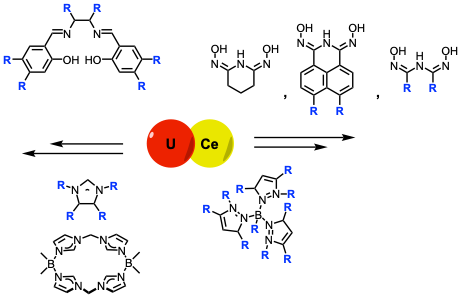An understanding of the bonding of plutonium is crucial for the separation of nuclear waste, and the management of nuclear security. Experimental studies of plutonium, however, are highly limited due to the high dangers associated with its handling and security. Thus, calculations and modeling backed by experimental data are important for developing a greater understanding of plutonium. We are working on the synthesis and characterization of surrogate complexes of uranium and cerium, both accepted substitutes for plutonium in the nuclear community. Our goal is to use these complexes as a marker to ensure that computational calculations and modeling meet a high level of accuracy. We intend to start with amidoximes and trispyrazolyl borates, both of which are known to coordinate to plutonium. We will also extend this study to two ligand systems with known affinities for other f-block elements: salens and N-heterocyclic carbenes. The use of these ligands will give us a robust platform for investigation of both the more ionic-character bonding of f-block elements with nitrogen and oxygen, and the covalent character of carbon bonding. This will also serve as a starting point for further ligand development, allowing us to investigate the effect of electronic character on bonding at the metal center. This project is in collaboration with Dr. Deborah Penchoff at the Institute for Nuclear Security, who will be focusing on the computational aspect of this project. In addition to the aforementioned project, we are working to make f-block complexes analogous to those we have previously synthesized with transition metals using macrocyclic-NHCs. We have investigated lanthanides, such as lutetium with Dr. Deborah Penchoff, as well as uranium, in a brief collaboration with Dr. Polly Arnold, formerly of the University of Edinburgh and currently of UC Berkeley. We seek to gain a more fundamental understanding of f-block macrocyclic NHC complexes.
 Figure 1: Ligands for uranium and cerium complexation based on confirmed plutonium structures and their electronic variants.
Figure 1: Ligands for uranium and cerium complexation based on confirmed plutonium structures and their electronic variants.